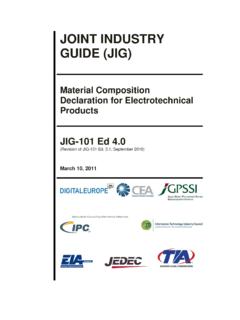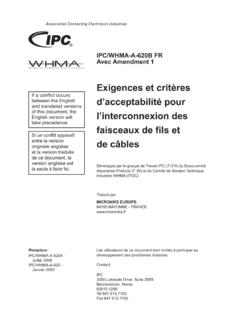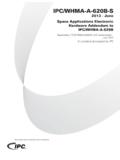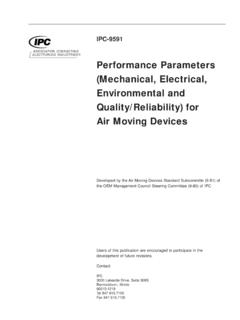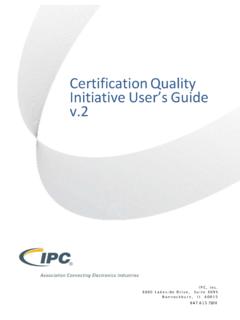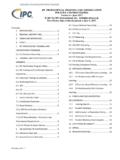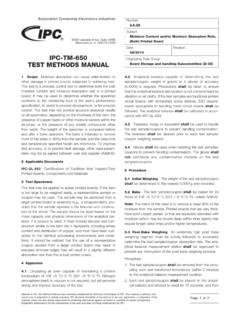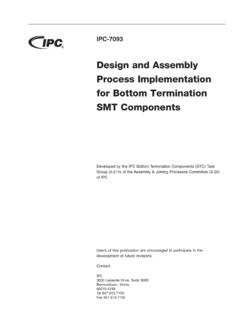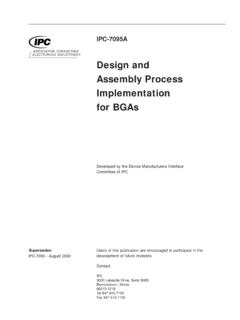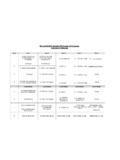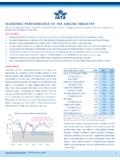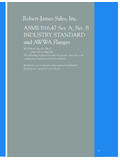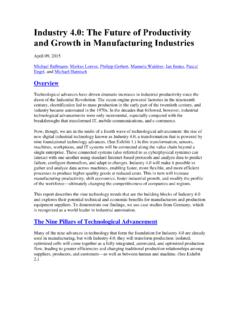Transcription of Appendix B RoHS Substances and Exemptions List …
1 March 2011 IPC-1752A. Appendix B. rohs Substances and Exemptions List The EU rohs Directive continues to be updated over time. As these changes are made, the most current exemption list will be added within the 1752A in a reasonable amount of time. Revision control will be based on the EU Directive document number. Declarations for products that have been previously declared will only be relative to the current EU Exemptions when the data was provided. On 24 September 2010 the European Commission published Commission Decision 2010/571/EU which replaced all previous rohs Exemptions lists . This represents a significant departure from previous Commission Decisions. Prior to September 2010, when the Commission published a Decision on the rohs Exemptions list then (apart from a few well publicized exceptions such as Exemptions 9a, 22, 28 and 35) the Decision added new Exemptions to the existing list. Commission Decision 2010/571/EU applies to all equipment which is placed on the EU market for the first time after 24.
2 September 2010, and implemented a major revision to the list of allowed rohs Exemptions : 13 Exemptions were deleted;. there were significant changes to the wording to 2 Exemptions , and 38 new Exemptions were introduced. Commission Decision 2010/571/EU also includes expiry dates for certain Exemptions . The list of valid rohs Exemptions will change every 6 months as certain Exemptions reach their expiry date. For example, some rohs Exemptions in the 2010/571/EU list expired in January 2011, some Exemptions expire in June 2011, more Exemptions expire in December 2011, and so on. The list of valid rohs Exemptions has now become a moving target and companies need to continually review which Exemptions are still valid for parts which are used to manufacture new products for sale in the EU. Table B5 provides the rohs Exemptions which are included in Commission Decision 2010/571/EU, and their expiry dates. Exemptions which have already expired (as at February 2011) are shown in bold type in Table B5.
3 Note that the rohs . Recast sets an expiry date of Q2 2016 for all other Exemptions listed in Table B5. However, industry can apply for an exemption to be reviewed and extended on a case-by-case basis. An application to renew an exemption must be submitted to the Commission no later than 18 months before the exemption is due to expire. Table B6 contains the list of rohs Exemptions that were valid before 24 September 2010, and their expiry dates where applicable. These Exemptions can be used for spare parts which are used to repair or refurbish items of equipment that had already been placed on the EU market before 24 September 2010, or before the expiry date of the exemption where applicable. A component which relies on an exemption for rohs compliance may require two separate declarations one declaration for use in new equipment put on the market after 24 September 2010 which references the rohs Exemptions in Table B5, and a second declaration for use as a spare part to repair or refurbish equipment that had already been placed on the market before 24 September 2010 which references the rohs Exemptions in Table B6.
4 Note: The German translation of Commission Decision 2010/571/EU adopts a slightly different numbering system (for example, in the German translation the exemption number 2(a)(3) is referred to as 2a. III). However, Commission Decision is EU law which applies equally in all Member States. Therefore, the numbering in Commission Decision 2010/571/EU can be used in all Member States. rohs Substances Unique ID Authority == IPC. Unique ID == EUROHS-0508. substance Category Name Threshold Cadmium/cadmium compounds by weight (100 ppm) of homogeneous materials Polybrominated biphenyls (PBBs) by weight (1 000 ppm) of homogeneous materials Polybrominated diphenyl ethers (PBDEs) by weight (1 000 ppm) of homogeneous materials Chromium VI compounds by weight (1 000 ppm) of homogeneous materials Lead/lead compounds by weight (1 000 ppm) of homogeneous materials Mercury/mercury compounds by weight (1 000 ppm) of homogeneous materials B5 rohs Exemptions listed in Commission Decision 2010/571/EU published 24 September 2010.
5 Unique ID Authority == IPC. Unique ID == EL2010/571/EU. Identity Description Expiry date Expires on 31 December 2011; mg may Mercury in single capped (compact) fluorescent lamps not exceeding (per be used per burner after 31 December 2011. 1(a). burner):For general lighting purposes less than 30 W: 5 mg until 31 December 2012; mg shall be used per burner after 31 December 2012. Mercury in single capped (compact) fluorescent lamps not exceeding (per 1(b) burner):For general lighting purposes greater than or equal to 30 W and less Expires on 31 December 2011; mg may than 50 W; 5 mg be used per burner after 31 December 2011. Mercury in single capped (compact) fluorescent lamps not exceeding (per 1(c) burner):For general lighting purposes greater than or equal to 50 W and less than 150 W; 5 mg Mercury in single capped (compact) fluorescent lamps not exceeding (per 1(d). burner):For general lighting purposes greater than or equal to 150 W; 15 mg Mercury in single capped (compact) fluorescent lamps not exceeding (per No limitation of use until 31 December 2011.)
6 1(e) burner):For general lighting purposes with circular or square structural shape 7 mg may be used per burner after 31. and tube diameter less than or equal to 17 mm December 2011. Mercury in single capped (compact) fluorescent lamps not exceeding (per 1(f). burner):For special purposes: 5 mg Mercury in double-capped linear fluorescent lamps for generation lighting 2(a)(1) purposes not exceeding (per lamp):Tri-band phosphor with normal lifetime and Expires on 31 December 2011; 4 mg may be a tube diameter less than 9 mm ( T2): 5mg used per lamp after 31 December 2011. Mercury in double-capped linear fluorescent lamps for generation lighting purposes not exceeding (per lamp):Tri-band phosphor with normal lifetime and 2(a)(2). a tube diameter greater than or equal to 9 mm and less than or equal to 17 mm Expires on 31 December 2011; 3 mg may be ( T5): 5mg used per lamp after 31 December 2011. Mercury in double-capped linear fluorescent lamps for generation lighting purposes not exceeding (per lamp):Tri-band phosphor with normal lifetime and 2(a)(3).
7 A tube diameter greater than 17 mm and less than or equal to 28 mm ( T8): Expires on 31 December 2011; mg may 5mg be used per lamp after 31 December 2011. Mercury in double-capped linear fluorescent lamps for generation lighting 2(a)(4) purposes not exceeding (per lamp):Tri-band phosphor with normal lifetime and Expires on 31 December 2012; mg may a tube diameter greater than 28 mm ( T12): 5 mg be used per lamp after 31 December 2012. Mercury in double-capped linear fluorescent lamps for generation lighting 2(a)(5) purposes not exceeding (per lamp):Tri-band phosphor with long lifetime (greater Expires on 31 December 2011; 5 mg may be than or equal to 25,000 h): 8 mg used per lamp after 31 December 2011. Mercury in other fluorescent lamps not exceeding (per lamp):Linear 2(b)(1) Expires on 13 April 2012. halophosphate lamps with tube greater than 28 mm ( T10 and T12): 10 mg Mercury in other fluorescent lamps not exceeding (per lamp):Non-linear 2(b)(2) Expires on 13 April 2016.
8 Halophosphate lamps (all diameters): 15 mg No limitation of use until 31 December 2011;. Mercury in other fluorescent lamps not exceeding (per lamp):Non-linear tri-band 2(b)(3) 15 mg may be used per lamp after 31. phosphor lamps with tube diameter greater than 17 mm ( T9). December 2011. No limitation of use until 31 December 2011;. Mercury in other fluorescent lamps not exceeding (per lamp):Lamps for other 2(b)(4) 15 mg may be used per lamp after 31. general lighting and special purposes ( induction lamps). December 2011. Mercury in cold cathode fluorescent lamps and external electrode fluorescent No limitation of use until 31 December 2011;. 3(a) lamps (CCFL and EEFL) for special purposes not exceeding (per lamp): Short mg may be used per lamp after 31. length (less than or equal to 500 mm) December 2011. Mercury in cold cathode fluorescent lamps and external electrode fluorescent No limitation of use until 31 December 2011.
9 3(b) lamps (CCFL and EEFL) for special purposes not exceeding (per lamp): 5 mg may be used per lamp after 31. Medium length (greater than 500 mm and less than or equal to 1,500 mm) December 2011. Mercury in cold cathode fluorescent lamps and external electrode fluorescent No limitation of use until 31 December 2011;. 3(c) lamps (CCFL and EEFL) for special purposes not exceeding (per lamp): Long 13 mg may be used per lamp after 31. length (greater than 1,500 mm) December 2011. No limitation of use until 31 December 2011;. 4(a) Mercury in other low pressure discharge lamps (per lamp) 15 mg may be used per lamp after 31. December 2011. Mercury in High Pressure Sodium (vapour) lamps for general lighting purposes No limitation of use until 31 December 2011;. 4(b)-I not exceeding (per burner) in lamps with improved colour rendering index Ra 30 mg may be used per burner after 31. greater than 60: P less than or equal to 155 W December 2011.
10 Mercury in High Pressure Sodium (vapour) lamps for general lighting purposes No limitation of use until 31 December 2011;. 4(b)-II not exceeding (per burner) in lamps with improved colour rendering index Ra 40 mg may be used per burner after 31. greater than 60: P greater than 155 W and less than or equal to 405 W December 2011. Mercury in High Pressure Sodium (vapour) lamps for general lighting purposes No limitation of use until 31 December 2011;. 4(b)-III. not exceeding (per burner) in lamps with improved colour rendering index Ra 40 mg may be used per burner after 31. March 2011 IPC-1752A. greater than 60: P greater than 405 W December 2011. No limitation of use until 31 December 2011;. Mercury in High Pressure Sodium (vapour) lamps for general lighting purposes 4(c)-I 25 mg may be used per burner after 31. not exceeding (per burner): P less than or equal to 155 W. December 2011. Mercury in High Pressure Sodium (vapour) lamps for general lighting purposes No limitation of use until 31 December 2011.
